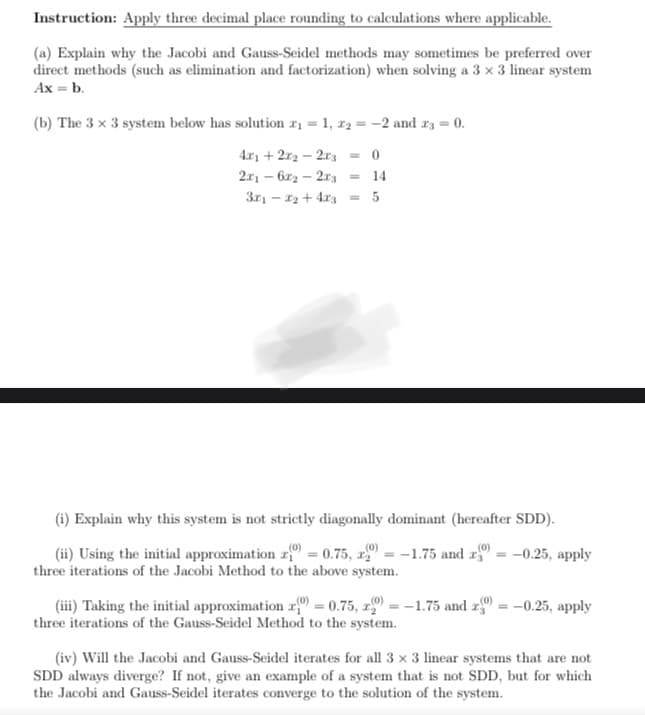(a) Explain why the Jacobi and Gauss-Seidel methods may sometimes be preferred over direct methods (such as elimination and factorization) when solving a 3 x 3 linear system Ax = b.
(a) Explain why the Jacobi and Gauss-Seidel methods may sometimes be preferred over direct methods (such as elimination and factorization) when solving a 3 x 3 linear system Ax = b.
Linear Algebra: A Modern Introduction
4th Edition
ISBN:9781285463247
Author:David Poole
Publisher:David Poole
Chapter2: Systems Of Linear Equations
Section2.1: Introduction To Systems Of Linear Equations
Problem 26EQ: The systems in Exercises 25 and 26 exhibit a lower triangular pattern that makes them easy to solve...
Related questions
Question

Transcribed Image Text:Instruction: Apply three decimal place rounding to calculations where applicable.
(a) Explain why the Jacobi and Gauss-Seidel methods may sometimes be preferred over
direct methods (such as elimination and factorization) when solving a 3 x 3 linear system
Ax = b.
(b) The 3 x 3 system below has solution ₁=1, x₂ = -2 and x3 = 0.
4x1 + 2x₂ - 2x3
0
2x16x22x3 = 14
3x₁x₂ + 4x3 = 5
-
(i) Explain why this system is not strictly diagonally dominant (hereafter SDD).
(0)
(0)
(ii) Using the initial approximation z(0) = 0.75, x= -1.75 and r = -0.25, apply
three iterations of the Jacobi Method to the above system.
(iii) Taking the initial approximation (0) = 0.75, x) = -1.75 and 20) = -0.25, apply
three iterations of the Gauss-Seidel Method to the system.
(iv) Will the Jacobi and Gauss-Seidel iterates for all 3 x 3 linear systems that are not
SDD always diverge? If not, give an example of a system that is not SDD, but for which
the Jacobi and Gauss-Seidel iterates converge to the solution of the system.
Expert Solution
This question has been solved!
Explore an expertly crafted, step-by-step solution for a thorough understanding of key concepts.
Step by step
Solved in 2 steps

Follow-up Questions
Read through expert solutions to related follow-up questions below.
Follow-up Question

Transcribed Image Text:(b) The 3 x 3 system below has solution ₁ = 1, 2 = -2 and x3 = 0.
0
4x1 + 2x2 - 2x3
2x16x22x3 = 14
3x1x₂ + 4x3 = 5
(i) Explain why this system is not strictly diagonally dominant (hereafter SDD).
(0)
(0)
(0)
(ii) Using the initial approximation z = 0.75, x=-1.75 and
three iterations of the Jacobi Method to the above system.
=
= -0.25, apply
(iii) Taking the initial approximation (0) = 0.75, x = -1.75 and r=-0.25, apply
three iterations of the Gauss-Seidel Method to the system.
(iv) Will the Jacobi and Gauss-Seidel iterates for all 3 x 3 linear systems that are not
SDD always diverge? If not, give an example of a system that is not SDD, but for which
the Jacobi and Gauss-Seidel iterates converge to the solution of the system.
Solution
Recommended textbooks for you

Linear Algebra: A Modern Introduction
Algebra
ISBN:
9781285463247
Author:
David Poole
Publisher:
Cengage Learning

Elementary Linear Algebra (MindTap Course List)
Algebra
ISBN:
9781305658004
Author:
Ron Larson
Publisher:
Cengage Learning

Big Ideas Math A Bridge To Success Algebra 1: Stu…
Algebra
ISBN:
9781680331141
Author:
HOUGHTON MIFFLIN HARCOURT
Publisher:
Houghton Mifflin Harcourt

Linear Algebra: A Modern Introduction
Algebra
ISBN:
9781285463247
Author:
David Poole
Publisher:
Cengage Learning

Elementary Linear Algebra (MindTap Course List)
Algebra
ISBN:
9781305658004
Author:
Ron Larson
Publisher:
Cengage Learning

Big Ideas Math A Bridge To Success Algebra 1: Stu…
Algebra
ISBN:
9781680331141
Author:
HOUGHTON MIFFLIN HARCOURT
Publisher:
Houghton Mifflin Harcourt

College Algebra (MindTap Course List)
Algebra
ISBN:
9781305652231
Author:
R. David Gustafson, Jeff Hughes
Publisher:
Cengage Learning

Algebra and Trigonometry (MindTap Course List)
Algebra
ISBN:
9781305071742
Author:
James Stewart, Lothar Redlin, Saleem Watson
Publisher:
Cengage Learning

Algebra & Trigonometry with Analytic Geometry
Algebra
ISBN:
9781133382119
Author:
Swokowski
Publisher:
Cengage